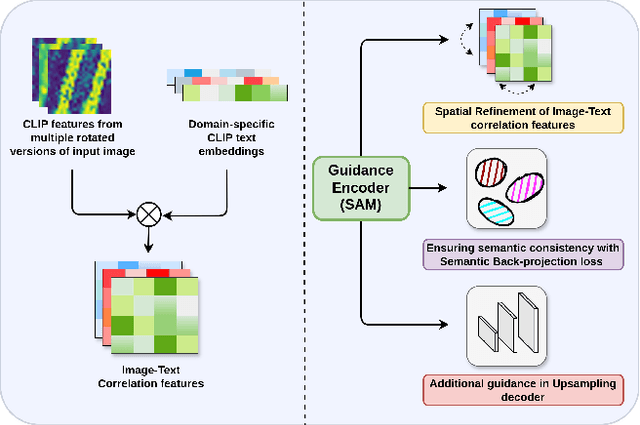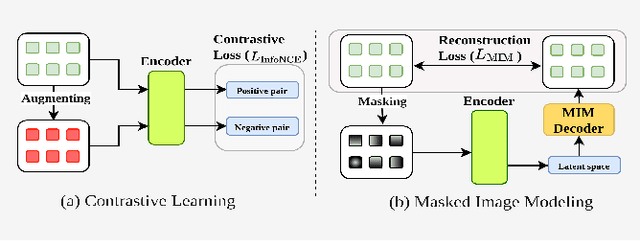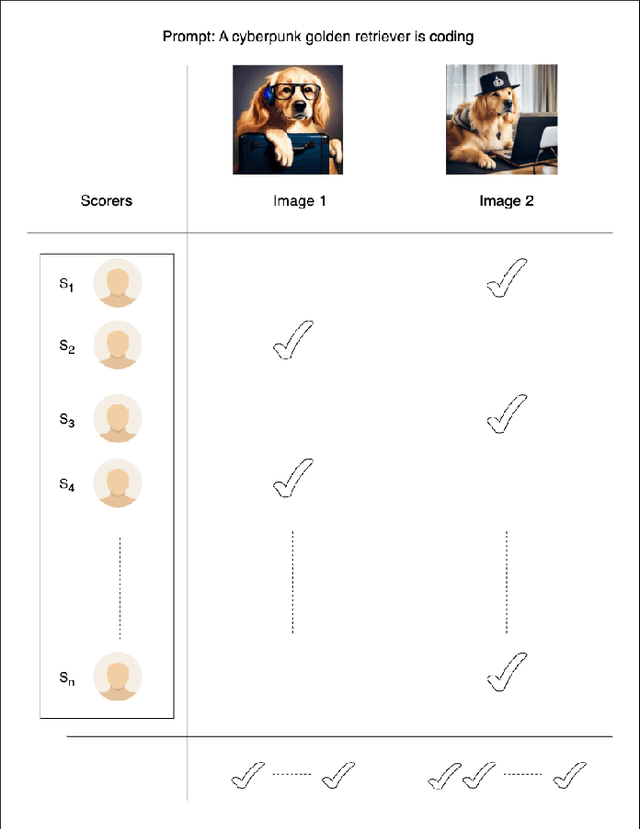Biplab Banerjee
Indian Institute of Technology Bombay, India
FedMVP: Federated Multi-modal Visual Prompt Tuning for Vision-Language Models
Apr 29, 2025Abstract:Textual prompt tuning adapts Vision-Language Models (e.g., CLIP) in federated learning by tuning lightweight input tokens (or prompts) on local client data, while keeping network weights frozen. Post training, only the prompts are shared by the clients with the central server for aggregation. However, textual prompt tuning often struggles with overfitting to known concepts and may be overly reliant on memorized text features, limiting its adaptability to unseen concepts. To address this limitation, we propose Federated Multimodal Visual Prompt Tuning (FedMVP) that conditions the prompts on comprehensive contextual information -- image-conditioned features and textual attribute features of a class -- that is multimodal in nature. At the core of FedMVP is a PromptFormer module that synergistically aligns textual and visual features through cross-attention, enabling richer contexual integration. The dynamically generated multimodal visual prompts are then input to the frozen vision encoder of CLIP, and trained with a combination of CLIP similarity loss and a consistency loss. Extensive evaluation on 20 datasets spanning three generalization settings demonstrates that FedMVP not only preserves performance on in-distribution classes and domains, but also displays higher generalizability to unseen classes and domains when compared to state-of-the-art methods. Codes will be released upon acceptance.
FrogDogNet: Fourier frequency Retained visual prompt Output Guidance for Domain Generalization of CLIP in Remote Sensing
Apr 23, 2025Abstract:In recent years, large-scale vision-language models (VLMs) like CLIP have gained attention for their zero-shot inference using instructional text prompts. While these models excel in general computer vision, their potential for domain generalization in remote sensing (RS) remains underexplored. Existing approaches enhance prompt learning by generating visual prompt tokens but rely on full-image features, introducing noise and background artifacts that vary within a class, causing misclassification. To address this, we propose FrogDogNet, a novel prompt learning framework integrating Fourier frequency filtering and self-attention to improve RS scene classification and domain generalization. FrogDogNet selectively retains invariant low-frequency components while eliminating noise and irrelevant backgrounds, ensuring robust feature representation across domains. The model first extracts significant features via projection and self-attention, then applies frequency-based filtering to preserve essential structural information for prompt learning. Extensive experiments on four RS datasets and three domain generalization tasks show that FrogDogNet consistently outperforms state-of-the-art prompt learning methods, demonstrating superior adaptability across domain shifts. Our findings highlight the effectiveness of frequency-based invariant feature retention in generalization, paving the way for broader applications. Our code is available at https://github.com/HariseetharamG/FrogDogNet
AerOSeg: Harnessing SAM for Open-Vocabulary Segmentation in Remote Sensing Images
Apr 12, 2025



Abstract:Image segmentation beyond predefined categories is a key challenge in remote sensing, where novel and unseen classes often emerge during inference. Open-vocabulary image Segmentation addresses these generalization issues in traditional supervised segmentation models while reducing reliance on extensive per-pixel annotations, which are both expensive and labor-intensive to obtain. Most Open-Vocabulary Segmentation (OVS) methods are designed for natural images but struggle with remote sensing data due to scale variations, orientation changes, and complex scene compositions. This necessitates the development of OVS approaches specifically tailored for remote sensing. In this context, we propose AerOSeg, a novel OVS approach for remote sensing data. First, we compute robust image-text correlation features using multiple rotated versions of the input image and domain-specific prompts. These features are then refined through spatial and class refinement blocks. Inspired by the success of the Segment Anything Model (SAM) in diverse domains, we leverage SAM features to guide the spatial refinement of correlation features. Additionally, we introduce a semantic back-projection module and loss to ensure the seamless propagation of SAM's semantic information throughout the segmentation pipeline. Finally, we enhance the refined correlation features using a multi-scale attention-aware decoder to produce the final segmentation map. We validate our SAM-guided Open-Vocabulary Remote Sensing Segmentation model on three benchmark remote sensing datasets: iSAID, DLRSD, and OpenEarthMap. Our model outperforms state-of-the-art open-vocabulary segmentation methods, achieving an average improvement of 2.54 h-mIoU.
MIMRS: A Survey on Masked Image Modeling in Remote Sensing
Apr 07, 2025


Abstract:Masked Image Modeling (MIM) is a self-supervised learning technique that involves masking portions of an image, such as pixels, patches, or latent representations, and training models to predict the missing information using the visible context. This approach has emerged as a cornerstone in self-supervised learning, unlocking new possibilities in visual understanding by leveraging unannotated data for pre-training. In remote sensing, MIM addresses challenges such as incomplete data caused by cloud cover, occlusions, and sensor limitations, enabling applications like cloud removal, multi-modal data fusion, and super-resolution. By synthesizing and critically analyzing recent advancements, this survey (MIMRS) is a pioneering effort to chart the landscape of mask image modeling in remote sensing. We highlight state-of-the-art methodologies, applications, and future research directions, providing a foundational review to guide innovation in this rapidly evolving field.
REJEPA: A Novel Joint-Embedding Predictive Architecture for Efficient Remote Sensing Image Retrieval
Apr 04, 2025



Abstract:The rapid expansion of remote sensing image archives demands the development of strong and efficient techniques for content-based image retrieval (RS-CBIR). This paper presents REJEPA (Retrieval with Joint-Embedding Predictive Architecture), an innovative self-supervised framework designed for unimodal RS-CBIR. REJEPA utilises spatially distributed context token encoding to forecast abstract representations of target tokens, effectively capturing high-level semantic features and eliminating unnecessary pixel-level details. In contrast to generative methods that focus on pixel reconstruction or contrastive techniques that depend on negative pairs, REJEPA functions within feature space, achieving a reduction in computational complexity of 40-60% when compared to pixel-reconstruction baselines like Masked Autoencoders (MAE). To guarantee strong and varied representations, REJEPA incorporates Variance-Invariance-Covariance Regularisation (VICReg), which prevents encoder collapse by promoting feature diversity and reducing redundancy. The method demonstrates an estimated enhancement in retrieval accuracy of 5.1% on BEN-14K (S1), 7.4% on BEN-14K (S2), 6.0% on FMoW-RGB, and 10.1% on FMoW-Sentinel compared to prominent SSL techniques, including CSMAE-SESD, Mask-VLM, SatMAE, ScaleMAE, and SatMAE++, on extensive RS benchmarks BEN-14K (multispectral and SAR data), FMoW-RGB and FMoW-Sentinel. Through effective generalisation across sensor modalities, REJEPA establishes itself as a sensor-agnostic benchmark for efficient, scalable, and precise RS-CBIR, addressing challenges like varying resolutions, high object density, and complex backgrounds with computational efficiency.
When Domain Generalization meets Generalized Category Discovery: An Adaptive Task-Arithmetic Driven Approach
Mar 21, 2025Abstract:Generalized Class Discovery (GCD) clusters base and novel classes in a target domain using supervision from a source domain with only base classes. Current methods often falter with distribution shifts and typically require access to target data during training, which can sometimes be impractical. To address this issue, we introduce the novel paradigm of Domain Generalization in GCD (DG-GCD), where only source data is available for training, while the target domain, with a distinct data distribution, remains unseen until inference. To this end, our solution, DG2CD-Net, aims to construct a domain-independent, discriminative embedding space for GCD. The core innovation is an episodic training strategy that enhances cross-domain generalization by adapting a base model on tasks derived from source and synthetic domains generated by a foundation model. Each episode focuses on a cross-domain GCD task, diversifying task setups over episodes and combining open-set domain adaptation with a novel margin loss and representation learning for optimizing the feature space progressively. To capture the effects of fine-tuning on the base model, we extend task arithmetic by adaptively weighting the local task vectors concerning the fine-tuned models based on their GCD performance on a validation distribution. This episodic update mechanism boosts the adaptability of the base model to unseen targets. Experiments across three datasets confirm that DG2CD-Net outperforms existing GCD methods customized for DG-GCD.
OSLoPrompt: Bridging Low-Supervision Challenges and Open-Set Domain Generalization in CLIP
Mar 20, 2025Abstract:We introduce Low-Shot Open-Set Domain Generalization (LSOSDG), a novel paradigm unifying low-shot learning with open-set domain generalization (ODG). While prompt-based methods using models like CLIP have advanced DG, they falter in low-data regimes (e.g., 1-shot) and lack precision in detecting open-set samples with fine-grained semantics related to training classes. To address these challenges, we propose OSLOPROMPT, an advanced prompt-learning framework for CLIP with two core innovations. First, to manage limited supervision across source domains and improve DG, we introduce a domain-agnostic prompt-learning mechanism that integrates adaptable domain-specific cues and visually guided semantic attributes through a novel cross-attention module, besides being supported by learnable domain- and class-generic visual prompts to enhance cross-modal adaptability. Second, to improve outlier rejection during inference, we classify unfamiliar samples as "unknown" and train specialized prompts with systematically synthesized pseudo-open samples that maintain fine-grained relationships to known classes, generated through a targeted query strategy with off-the-shelf foundation models. This strategy enhances feature learning, enabling our model to detect open samples with varied granularity more effectively. Extensive evaluations across five benchmarks demonstrate that OSLOPROMPT establishes a new state-of-the-art in LSOSDG, significantly outperforming existing methods.
BalancedDPO: Adaptive Multi-Metric Alignment
Mar 16, 2025



Abstract:Text-to-image (T2I) diffusion models have made remarkable advancements, yet aligning them with diverse preferences remains a persistent challenge. Current methods often optimize single metrics or depend on narrowly curated datasets, leading to overfitting and limited generalization across key visual quality metrics. We present BalancedDPO, a novel extension of Direct Preference Optimization (DPO) that addresses these limitations by simultaneously aligning T2I diffusion models with multiple metrics, including human preference, CLIP score, and aesthetic quality. Our key novelty lies in aggregating consensus labels from diverse metrics in the preference distribution space as compared to existing reward mixing approaches, enabling robust and scalable multi-metric alignment while maintaining the simplicity of the standard DPO pipeline that we refer to as BalancedDPO. Our evaluations on the Pick-a-Pic, PartiPrompt and HPD datasets show that BalancedDPO achieves state-of-the-art results, outperforming existing approaches across all major metrics. BalancedDPO improves the average win rates by 15%, 7.1%, and 10.3% on Pick-a-pic, PartiPrompt and HPD, respectively, from the DiffusionDPO.
"My life is miserable, have to sign 500 autographs everyday": Exposing Humblebragging, the Brags in Disguise
Dec 28, 2024



Abstract:Humblebragging is a phenomenon where individuals present self-promotional statements under the guise of modesty or complaints. For example, a statement like, "Ugh, I can't believe I got promoted to lead the entire team. So stressful!", subtly highlights an achievement while pretending to be complaining. Detecting humblebragging is important for machines to better understand the nuances of human language, especially in tasks like sentiment analysis and intent recognition. However, this topic has not yet been studied in computational linguistics. For the first time, we introduce the task of automatically detecting humblebragging in text. We formalize the task by proposing a 4-tuple definition of humblebragging and evaluate machine learning, deep learning, and large language models (LLMs) on this task, comparing their performance with humans. We also create and release a dataset called HB24, containing 3,340 humblebrags generated using GPT-4o. Our experiments show that detecting humblebragging is non-trivial, even for humans. Our best model achieves an F1-score of 0.88. This work lays the foundation for further exploration of this nuanced linguistic phenomenon and its integration into broader natural language understanding systems.
Foundation Models and Adaptive Feature Selection: A Synergistic Approach to Video Question Answering
Dec 12, 2024
Abstract:This paper tackles the intricate challenge of video question-answering (VideoQA). Despite notable progress, current methods fall short of effectively integrating questions with video frames and semantic object-level abstractions to create question-aware video representations. We introduce Local-Global Question Aware Video Embedding (LGQAVE), which incorporates three major innovations to integrate multi-modal knowledge better and emphasize semantic visual concepts relevant to specific questions. LGQAVE moves beyond traditional ad-hoc frame sampling by utilizing a cross-attention mechanism that precisely identifies the most relevant frames concerning the questions. It captures the dynamics of objects within these frames using distinct graphs, grounding them in question semantics with the miniGPT model. These graphs are processed by a question-aware dynamic graph transformer (Q-DGT), which refines the outputs to develop nuanced global and local video representations. An additional cross-attention module integrates these local and global embeddings to generate the final video embeddings, which a language model uses to generate answers. Extensive evaluations across multiple benchmarks demonstrate that LGQAVE significantly outperforms existing models in delivering accurate multi-choice and open-ended answers.
 Add to Chrome
Add to Chrome Add to Firefox
Add to Firefox Add to Edge
Add to Edge